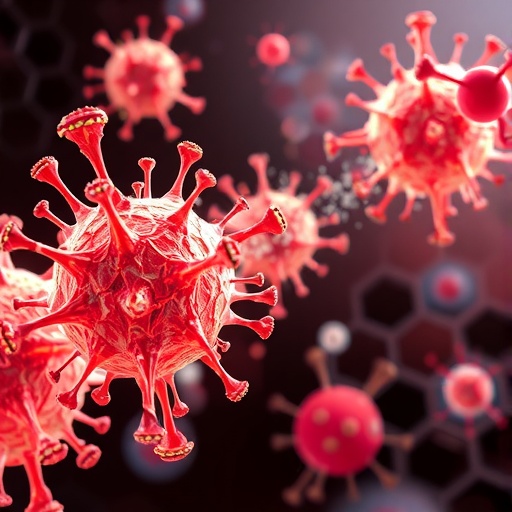In a groundbreaking new study published in Nature, researchers have unraveled the intricate molecular dance between the kinase ZAK and ribosomal RNA at the site of ribosome collisions. This discovery illuminates previously unknown mechanisms by which cells sense and respond to translational stress, potentially opening new vistas for understanding cellular stress responses as well as therapeutic interventions.
The study meticulously explores the interaction between ZAK, a pivotal kinase involved in ribosomal stress signaling, and the 18S ribosomal RNA, a core part of the 40S subunit of the ribosome. Using state-of-the-art crosslinking and immunoprecipitation sequencing (CLIP-seq) techniques, the team mapped the binding footprints of ZAK on the ribosome with unprecedented precision, yielding crucial insights into how ZAK identifies and binds to collided ribosomes during translational stalling.
Central to their findings is the revelation that the C-terminal domain of ZAK plays a decisive role in ribosome engagement. By employing mutant variants of ZAK lacking this C-terminal segment, the researchers demonstrated a marked decrease in ribosomal binding, affirming that the C terminus facilitates direct contacts with specific regions of the 18S rRNA. This domain thus acts as a sensor that ‘samples’ ribosomal sites, even in the absence of overt collision-induced stress.
Notably, the researchers identified two distinct rRNA expansion segments—ES7 and ES6b/c—that serve as critical interaction hotspots for ZAK. Under basal conditions, ZAK predominantly interacts with ES7, located between bases 1117 and 1195 of the 18S rRNA. This interaction appears to represent a surveillance or sampling mode, wherein ZAK continuously surveys ribosomes, poised to mount a rapid response if translational perturbations occur.
Upon exposure to anisomycin (ANS), a known inducer of ribosome collision and stalling, a secondary binding footprint uniquely emerged at ES6b/c (bases 710–766), implicating this region as a crucial contact point on collided ribosomes. This ES6 patch interaction is thought to be a hallmark of ribosomal collision recognition, triggering downstream signaling cascades mediated by ZAK to initiate cellular stress responses.
Validation of these observations using both wild-type and kinase-inactive forms of ZAK strengthens the argument for a collision-specific interaction module within the C-terminus. Even with enzymatically inactive ZAK, the binding pattern remains consistent, suggesting that ribosome association is independent of ZAK’s kinase activity but essential for its spatial positioning to sense collision events.
An intriguing insight from the study is the specificity of ZAK’s interaction with the 40S subunit’s rRNA rather than the 60S subunit. No enrichment of ZAK binding was observed on 28S rRNA sequences associated with the large ribosomal subunit, reinforcing the idea that ZAK’s molecular recognition centers on the small subunit’s structure, corroborating recent structural data on ribosome collisions.
Further metagene analyses revealed ZAK footprints enriched within the coding sequences of mRNAs engaged by ribosomes. This observation implies that ZAK situates itself strategically near mRNA entry and exit sites on the 40S subunit, placing it in a prime position to detect changes in translation dynamics that could herald ribosomal stalling or collision.
Contrary to previous suggestions implicating helix 14 as a ZAK interaction site, the current exhaustive CLIP-seq data shows no significant foot-printing in this region across all tested ZAK constructs. This refines our understanding of ZAK’s ribosomal interface and rules out prior models that positioned helix 14 at the heart of ZAK engagement.
These findings were buttressed by structural correlates derived from complementary cryo-electron microscopy experiments, highlighting conformational changes in ribosomal RNA expansion segments upon collision and ZAK engagement. Together, these integrate structural and biochemical insights, painting a holistic picture of ZAK’s mechanistic role in collision sensing.
The implications of this study extend well beyond the fundamental biology of translation regulation. Understanding how ZAK detects ribosome collisions provides valuable clues to the activation of stress signaling pathways that mediate cellular homeostasis, immune responses, and even the mechanisms underlying various diseases related to protein synthesis dysfunction.
By elucidating the molecular underpinnings of ZAK-ribosome interactions, this research not only advances our comprehension of proteostasis but may also inform drug discovery efforts targeting translational stress pathways. Future therapies could leverage this knowledge to modulate stress responses in conditions ranging from viral infections to cancer where ribosome collisions are prevalent.
In sum, this landmark investigation decisively establishes that the C-terminal domain of ZAK functions as a molecular sensor that docks onto specific 18S rRNA expansion segments, enabling cells to detect and respond to ribosomal collisions rapidly. This adds a significant chapter to the narrative of translation quality control and ribosome-associated signaling.
As the scientific community digests these insights, it is expected that further studies will explore how ZAK activity integrates with other ribosomal quality control factors, thus continuing to unravel the complexities of cellular surveillance mechanisms maintaining protein synthesis fidelity.
This research marks a pivotal step toward a comprehensive map of the ribosomal collision landscape and the molecular sentinels like ZAK that patrol it, ushering in an era of novel interventions for diseases rooted in translational stress.
Subject of Research: Molecular interaction of kinase ZAK with collided 40S ribosomal subunit RNA.
Article Title: ZAK activation at the collided ribosome.
Article References:
Huso, V.L., Niu, S., Catipovic, M.A. et al. ZAK activation at the collided ribosome. Nature (2025). https://doi.org/10.1038/s41586-025-09772-8




